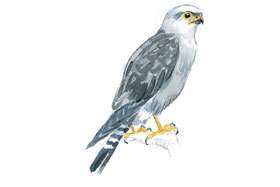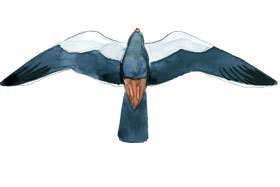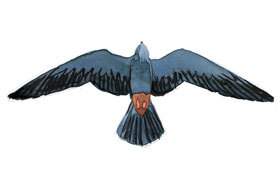
Peregrine Passion
 Those who have the good fortune to have seen Peregrines in their aerial courtship manoeuvres say the display is more thrilling than the rarity of the sighting. Peregrine Falcons do a mean line in love - partners stay together for life (although if one dies, it is soon replaced).
Those who have the good fortune to have seen Peregrines in their aerial courtship manoeuvres say the display is more thrilling than the rarity of the sighting. Peregrine Falcons do a mean line in love - partners stay together for life (although if one dies, it is soon replaced).
Peter Steyn describes how Peregrine courtship displays include "high circling, undulating dives, looping-the-loop and figure of eight patterns. There is much aerial 'play' involved and the male chases the female, who will turn and present her talons to him. Sometimes they touch bills or 'kiss' in flight".
Peregrine Falcon (Falco peregrinus)
Afrikaans: Swerfvalk
A sighting of the fastest bird in the world is a rare and rewarding experience that can happen anywhere in Kruger. The Peregrine is a specialist bird-killer and the subject of ongoing debates about how fast it can fly and whether or not there is a resident population in Kruger.
Researchers trying to determine how fast Peregrines can fly have come up with a range of results. Various studies show that the falcon diving in its spectacular stoop attained speeds of between 160km/h at the lower end of the range and 410km/h at the top end. Conventional wisdom holds that its diving speed is around 240km/h.
There is also a debate as to how effective a hunter the Peregrine is. Respected researchers like Peter Steyn believe it is able 'to capture prey with little difficulty and there are long periods of inactivity when it merely loafs about on its favourite cliff.
Research cited in Roberts VII indicates, however, that the Peregrine Falcon may sometimes fly too fast for its own good. The study claimed it had a poor strike rate relative to other raptors, and that only 7.5% of attacks made by the Peregrine resulted in a kill, compared to the 90% success rate of Ospreys.
There is a confirmed Peregrine breeding site in the Lanner Gorge cliffs along the Luvuvhu upstream from the bridge.
Peregrine Falcon Characteristics
Resident
Prey
Diet almost exclusively of birds under 300g - African Black Swifts, Alpine Swifts, African Green-Pigeons, Lilac-breasted Rollers, starlings and sparrows.
Where best to find them
Mostly northern Kruger where it hunts in the Makuleke and Pafuri open woodlands and nests in the gorges of the Luvuvhu River; but can be seen anywhere in the Park.
Lanner Falcon (Falco biarmicus)
Afrikaans: Edelvalk
 The spectacular Lanner Gorge in northern Kruger was named by ranger Mike English after the Lanner Falcons that have been recorded in these sandstone cliffs towering above the Luvuvhu River. There are an estimated 1 300 breeding pairs in north-eastern South Africa, over 90% of which breed in cliffs or ravines. The highest density of Lanners in southern Africa is found in the Lesotho mountains.
The spectacular Lanner Gorge in northern Kruger was named by ranger Mike English after the Lanner Falcons that have been recorded in these sandstone cliffs towering above the Luvuvhu River. There are an estimated 1 300 breeding pairs in north-eastern South Africa, over 90% of which breed in cliffs or ravines. The highest density of Lanners in southern Africa is found in the Lesotho mountains.
The Lanner often perches quite openly on dead trees in open grasslands near cliffs or ravines. It is a fast flyer - not as fast as the Peregrine - but it's a more versatile hunter, adept at seizing a pigeon in mid-air or a rat off the ground. It also has the unusual practice of attacking prey that flies directly towards it - most other raptors pursue fleeing prey.
The Lanner uses the same diving stoop as the Peregrine to catch its prey, but it is also effective at seizing small birds in a level chase, sometimes just a few metres above the ground. Pairs sometimes hunt together and often wait in ambush for other birds at water holes.
Like the Peregrine, it has dramatic courtship displays in which the male swoops down on the female who turns to meet him and presents her talons. They sometimes feed each other prey during flight. They often occupy disused Bateleur nests as they have a later breeding cycle.
Lanner Falcon Characteristics
Migrant
Prey
Forty percent of diet consists of doves and pigeons, also francolins, plovers, mousebirds; also hunts rats and other small mammals.
Where best to find them
Uncommon; sightings throughout Park but particularly around Punda and Makuleke and the northern mopaneveld.
Eurasian Hobby* (Falco subbuteo)
Afrikaans: Europese Boomvalk
 The Eurasian Hobby* is most often seen at dusk, particularly after heavy rains when termites emerge from the earth. This palaeoarctic migrant's movements appear to be quite closely linked to rainfall patterns that are erratic and unpredictable. It flies fast, flapping its wings a few times and then gliding for a long distance. It is able to catch termites in its talons in mid-flight and barely misses a wing-beat putting the insect in its beak.
The Eurasian Hobby* is most often seen at dusk, particularly after heavy rains when termites emerge from the earth. This palaeoarctic migrant's movements appear to be quite closely linked to rainfall patterns that are erratic and unpredictable. It flies fast, flapping its wings a few times and then gliding for a long distance. It is able to catch termites in its talons in mid-flight and barely misses a wing-beat putting the insect in its beak.
The Eurasian Hobby* often hunts birds around nightfall, taking advantage of the fading light to give it the advantage of a surprise attack on nesting weavers and other birds. If it loses the element of surprise, its intended victim often escapes quite easily. Little Swifts, for instance, simply fly higher. They know that this neutralises the Eurasian Hobby's* danger to them as it needs to expend more energy to get enough altitude for its characteristic dive-bombing attack.
Eurasian Hobby Characteristics
Migrant
Prey
Mostly termites which it hawks on the wing; also small birds like swallows; very occasionally mammals.
Where best to find them
Sabie River around Skukuza; itinerantly in lightly wooded areas throughout the Park, particularly close to rivers.
|
|
|
The fovea exists in a pit where the slanting walls bend the light in a way that magnifies the image even further, allowing birds to pick up movements several kilometres away. Where people see just three primary colors, eagles see five, enabling them to pick out even well-camouflaged prey. The colour of the eye appears to be unrelated to how well a particular species can see - in other words red eyes don't provide any better vision necessarily than yellow eyes. |
Amur Falcon* (Falco amurensis)
Afrikaans: Oostelike Rooipootvalk
 The Amur Falcon* takes its name from its Asian breeding grounds around the Amur River between China and Russia. It is a gregarious migrant usually arriving in the Park in the company of the Lesser Kestrel in November or December. They stay until the last summer rains, which are usually in March.
The Amur Falcon* takes its name from its Asian breeding grounds around the Amur River between China and Russia. It is a gregarious migrant usually arriving in the Park in the company of the Lesser Kestrel in November or December. They stay until the last summer rains, which are usually in March.
Ahead of their departure, they often gather in huge flocks over the eastern grasslands and Lebombo in a last communal feed before heading back north for summer in Siberia and northern Manchuria. Their northern return flight has long puzzled scientists as the birds seem to disappear ("See Mysterious Flight of the Falcons").
The Amur Falcon's preferred habitat is Kruger's eastern, lightly wooded grasslands where it is found in small or large groups. The birds co-exist comfortably with both the Lesser Kestrel and the Red-footed Falcon* whose habitats it overlaps. The birds sometimes gather in large communal roosts at night - 5 000 birds in a single roost is a regular occurance in Zimbabwe but the numbers in Kruger appear to be much lower.
Amur Falcon Characteristics
Migrant
Prey
Lives mostly on insects which it catches in the air; particularly fond of grasshoppers and termites.
Where best to find them
Found throughout the Park but encountered in open grassland, particularly near Punda, Satara, Orpen and Pretoriuskop; often gathers around Muntshe Hill ahead of March departure.
Red-footed Falcon* (Falco verspertinus)
Afrikaans: Westelike Rooipootvalk
 The Red-footed Falcon*generally prefers the drier habitats of south-western Africa, but is sometimes recorded in Kruger, particularly in the drier parts of the eastern grasslands. It is a gregarious bird, roosting communally at night in tall trees.
The Red-footed Falcon*generally prefers the drier habitats of south-western Africa, but is sometimes recorded in Kruger, particularly in the drier parts of the eastern grasslands. It is a gregarious bird, roosting communally at night in tall trees.
It is often found with the Amur Falcon* and Lesser Kestrel in mixed feeding flocks. It arrives in November or December in Kruger, far from its breeding grounds in Eastern Europe and Mongolia. It heads north again in March.
Red-footed Falcon Characteristics
Migrant
Prey
Grasshoppers, termites and other insects.
Where best to find them
Found in drier areas in Kruger often with other kestrels near Punda, Satara, Orpen and Pretoriuskop.
Lesser Kestrel (Falco naumanni)
Afrikaans: Kleinrooivalk
 The Lesser Kestrel is a light and graceful flyer that appears to delight in surfing the wind. It arrives in southern Africa in October and is more commonly seen in the highveld grasslands than in the lowveld. The Lesser Kestrel roosts in huge communal flocks, often near towns. There is a roost in Senekal in the Free State that has been occupied continuously for over three decades by noisy flocks of this Eurasian migrant.
The Lesser Kestrel is a light and graceful flyer that appears to delight in surfing the wind. It arrives in southern Africa in October and is more commonly seen in the highveld grasslands than in the lowveld. The Lesser Kestrel roosts in huge communal flocks, often near towns. There is a roost in Senekal in the Free State that has been occupied continuously for over three decades by noisy flocks of this Eurasian migrant.
In Kruger, the Lesser Kestrel is usually seen in open grasslands, often with the Amur Falcon*. The Lesser Kestrel feeds almost entirely on insects, catching them either in mid-flight or stooping down to take them off the ground. A memorable birding experience is to see them fattening up for their return journey northwards.
Hundreds, sometimes thousands of kestrels and falcons can gather over the eastern grasslands near the Lebombo after the last summer rains to hit the last termite emergences before heading home.
Lesser Kestrel Characteristics
Migrant
Prey
Mainly locusts and termites; occasionally small birds like finches.
Where best to find them
Widely scattered in lightly wooded grasslands throughout the Park but uncommon in the extreme north and south.
Dickinson's Kestrel (Falco Dickinsoni)
Afrikaans: Dickinsonse Valk
 The speciality of northern Kruger is Dickinson's Kestrel - a stocky, grey raptor with a squarish head. It is an Afro-tropical species and is not really found south of the Baobab belt. Dickinson's Kestrel is closely associated with Baobabs and Borassus-palms, as it nests in the hollows of these trees.
The speciality of northern Kruger is Dickinson's Kestrel - a stocky, grey raptor with a squarish head. It is an Afro-tropical species and is not really found south of the Baobab belt. Dickinson's Kestrel is closely associated with Baobabs and Borassus-palms, as it nests in the hollows of these trees.
It has a slow and deliberate flight although it is capable of sudden bursts of speed, especially when chasing prey. It lives mostly on insects and occasionally small birds, which it decapitates before feeding them to nestlings. This kestrel was first described by the young, medical missionary Dr John Dickinson, who noticed it during an expedition with Dr Livingstone to the Shire River valley of southern Malawi during the 1860s.
As with many of the birding pioneers, Dickinson had an unfortunate end, dying in 1863 at the age of 34 of blackwater fever contracted in the Shire River area. The Greater Kestrel is a rare visitor to Kruger - one has been recorded nesting in a Baobab two metres below a Lappet-faced Vulture nest at Klopperfontein near Pafuri in 2002. It successfully raised its two chicks and then departed.
Dickinson's Kestrel Characteristics
Resident
Prey
Mostly insects but otherwise a varied diet of small birds, bats, rodents and lizards.
Where best to find them
Mostly around Punda Maria, Klopperfontein and the Baobab territory of the north.
The Greater Kestrel
The Greater Kestrel is a rare visitor to Kruger - one has been recorded nesting in a Baobab two metres below a Lappet-faced Vulture nest at Klopperfontein near Pafuri in 2002. It successfully raised its two chicks and then departed.
|
|

 Adult Height
Adult Height

 Adult Height
Adult Height
 Claw and Beak
Claw and Beak Why Raptors See So Well Scientists believe that birds of prey can see eight times more clearly than people can. The secret of their astounding vision is a depression in the retina called the fovea, which has approximately one million light-sensitive cells or cones per square millimetre; that is about eight times as many as people have.
Why Raptors See So Well Scientists believe that birds of prey can see eight times more clearly than people can. The secret of their astounding vision is a depression in the retina called the fovea, which has approximately one million light-sensitive cells or cones per square millimetre; that is about eight times as many as people have.



 Hyaena and Vultures
Hyaena and Vultures